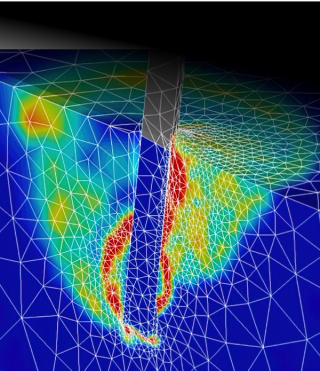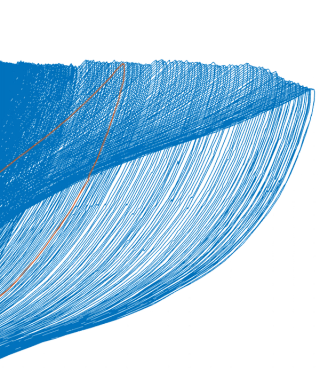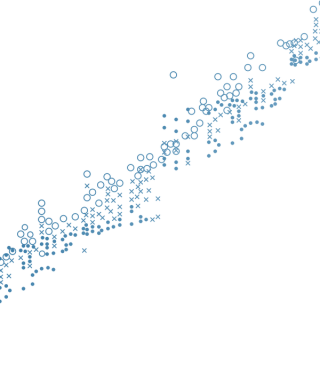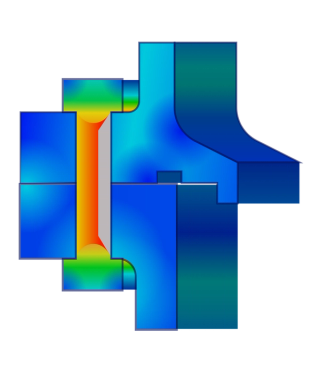


Complete site conditions integration
The atmospheric and oceanographic site conditions across a wind farm site interact with one-another to define the loading on the support structure foundation, both via the wind turbine and directly on the support structure itself. The geotechnical site conditions then define the response of the support structure, the dynamic characteristics of which feed back to further influence the loading. Hence the overall successful design of an offshore wind farm must not only capture the individual site conditions, but also their complex and collective interaction.
The challenge is further compounded by the governing site conditions being spatially variable across a site, or in some cases variable over the design lifetime, for example, seabed levels in environments subject to sediment mobility. This brings a further challenge of needing to generalise, or cluster, site conditions appropriately and sufficiently to enable practical design, but whilst retaining sufficient resolution to deliver a design which is optimised for each individual location.
Wood Thilsted’s approach to addressing this challenge and the underlying site conditions integration is founded on deep, discipline-specific understanding of the many different site conditions, and also their interaction. This is captured in our workflow using innovative software twinned with collaborative, inter-disciplinary working practices.
""Our software-driven workflow starts with building blocks which enable expert derivation and characterisation of the different site conditions, for example, clustering algorithms for metocean design load cases, or routines to derive and calibrate site-specific geotechnical correlations. It then combines these conditions in engineering routines which model their interaction and optimise the overall design. ""




Pile soil analysis
Our 3D FE analyses of the soil structure interaction is fully integrated and controlled by our in-house monopile design software (Morpheus) to ensure consistency between data assumed for foundation design derivation and the 3D FE model. We have undertaken an extensive FE benchmark test toward the PISA pile load tests in Cowden and Dunkirk to prove accuracy and integrity of the models we use, to ensure that the simulations provide trustworthy and accurate results. Our models are calibrated solely to soil test data without application of post-fitting parameters. Therefore, when properly calibrated, our 3D FE models are highly reliable and capable of evaluating the impact of changing modelling conditions, such as changes of pile diameter, soil layering and parameters, etc.
The calibration of the constitutive models follow an innovative approach where the calibration parameters are automatically calibrated against relevant high-quality laboratory data using the least mean square method to find the most optimum fit to each individual test. This implies that up to hundreds of simulations are performed for each test leading to optimised calibration parameters for each governing geotechnical unit.
""Once the constitutive model is calibrated, soil reaction curves covering the geometrical space of the foundation designs are extracted from the 3D model to be applied in a simpler finite element model. The simpler finite element model is less computationally demanding when deriving hundreds of offshore foundation designs and therefore allows for a greater degree of structural optimisation, leading to highly optimised position, specific foundation designs accounting for fabrication and installation constraints. ""




Cyclic degradation
Wood Thilsted has developed a novel cyclic degradation methodology for assessing the effects of cyclic loading arising from wave and wind actions on offshore foundations. For laterally loaded foundations this method is calibrated and benchmarked against the PISA cyclic pile load tests and is considered to reflect a rather high degree of accuracy given the uncertainties and complexity of modelling this problem statement.
Cyclic loading can lead to considerable strength degradation and cyclic mobility which affects the effective geotechnical properties of the soil volume supporting the foundation. This can result in excessive deformations, collapse and/or fatigue damage reducing the design life or the operational constraints of the structure if not carefully accounted for. Thus, accurate modelling of cyclic effects is vital to achieve an optimised and safe design. Applying soil reaction curves derived through 3D FEA modelling requires a efficient cyclic framework in order to be applicable for substructure and foundation design derivation as these reactions offer a more accurate and less conservative prediction of design stiffness and capacity. Therefore, capturing effects of cyclic loads is of high importance.
""The method is implemented in Wood Thilsted’s structural optimisation algorithm allowing for complex cyclic degradation analyses for each foundation design without compromising the computational costs leading to a fast turnaround in case there are any project risks that needs to be accommodated due to last minute project changes. ""




Seismic and liquefaction
To derive acceleration time series arising from seismic loading Wood Thilsted applies equivalent linear or non-linear site response analysis (SRA) techniques. Although these methods in themselves are quite conventional the innovative solution arises from how the assessment is coupled to the geotechnical interpretation, liquefaction and seismic load assessment of offshore foundation structures. Using our geotechnical interpretation software an automatic interface to our seismic software is established where we perform the site response analysis at each WTG location. For any geotechnical parameter relevant for the SRA we perform a complete sweep to assess the sensitivity of the analysis to ensure that the seismic conditions are appropriately captured to reduce project risks and thereby accommodate any uncertainties related to the seismic assessment. Furthermore, this information is linked to a liquefaction assessment where the acceleration time series are evaluated based on an in-house methodology using advanced cyclic laboratory tests to calculate the impact on the stiffness and strength due to seismic loading. This calculation does not simply output a binary solution but yields the amount of strength and stiffness degradation that occurs based on a given seismic event. The acceleration time series and liquefaction results are further applied to evaluate the seismic loads on the offshore foundation design through a time domain analysis. The analysis is performed based on an integrated model that accurately represents its dynamic behaviour. In contrast to e.g. wave loads, which for practical applications can be determined with sufficient accuracy prior to analysis without accounting for the wave-structure, the dynamic inertia forces due to ground acceleration must be evaluated from an integrated model to capture the dynamic interaction between the superstructure - tower and rotor-nacelle-assembly (RNA) - and the substructure. Traditionally, the seismic loading is applied to the integrated structure in the form of a time-varying acceleration field derived from the SRA. However, Wood Thilsted applies a more sophisticated approach where seismic loads are applied in the form of free-field displacement time series obtained by integration of the time varying accelerations. This approach is more accurate and allows for inclusion of the site specific depth-variation of the seismic loads.
"The free-field displacements are applied to the monopile through the linear (or non-linear) soil springs representing the soil-structure interaction at each soil layer with a sufficiently fine discretization. The response of the integrated structure is calculated via direct time integration, hence nonlinearities e.g. due to soil-structure interaction for large displacements or liquefaction can be accounted for. "




Holistic engineering process
In our holistic approach to engineering, we consider design as an interconnected whole in which we seek to integrate the software efficiency with skills of designers from multiple disciplines into a collaborative effort for the good of the project. Using our efficient design software we eliminate most manual design processes whereby our engineers can devote their efforts to search for value-adding levers to improve designs by use of brute power to undertake millions and millions of design simulations. The results provide our engineers with a valuable holistic cross-discipline understanding of underlying design drivers, and it enables them to challenge any assumption, constraint, design method or design choice which is preventing a fully cost-optimised design to be achieved.
While reaching an acceptable design in a pre-defined step-by-step serial design process is straight forward and can be achieved with a relatively small engineering effort, the path to achieving a high-quality optimised design is only possible by numerous design loops including multiple design re-assessments, sensitivity studies, re-designs, repeated 3D FE calculations, re-clustering etc.
"The key to an efficient iterative design process is our multi-disciplinary engineers and a fully streamlined automated dataflow from early site assessment output to detailed analysis results. "




Online reporting system (Dashboard)
We have developed an online dashboard for better communicating the design progress with our Clients. The dashboard gives our Clients the possibility for a visual update of the development in the overall foundation tonnage (e.g. monopile and transition piece) and will provide drawings and design information through our unique client information portal. This is a web-based access to all design results and is used as our primary method for communication of design stage results. We augment this data (which includes detailed utilisation plots, stiffness results and foundation geometry and weights) with technical discussion and conclusions, provided in a slide deck format. Our automated processes allow a rapid delivery of MTOs in client defined formats, which can be downloaded from the portal.
"Our Clients have found the use of the dashboard really helpful in understanding the design development, and very engaging compared to conventional written reporting, which can stretch to many pages."




Geometry optimisation and sensitivity studies
Individual assessment of the optimal geometry within a full windfarm allows for park-wise optimization rather than sub-optimal choice based on few selected positions only. An optimization process would typically include +1000 individually fully optimised MP-designs during sensitivity studies, and these analyses would be repeated iteratively as various constraints and assumptions are being refined by our engineers. Besides overall geometry, this also includes cost optimisations for multiple fabricator requirements/preferences, multiple WTG suppliers, site layout and identification of spare positions for early project phases as well as mass optimisation vs fabrication complexity/grinding.
"Our clustering approach, can besides standard measures as water depth and frequency/stiffness, also account for variations in tower, metocean conditions and geotechnical properties. And using our efficient and automated optimization tools for design and load assessment allows for direct assessment of the effects and potential improvements obtained by various clustering strategies. "




Transport & Installation innovations
Wood Thilsted has extensive experience with drivability and other transport and installation (T&I) assessments for demonstration of the feasibility of transporting and installing some of the largest monopiles ever designed. The thin-walled nature of modern monopiles require careful attention during the various lift and handling phases. While we utilise efficient tools for screening purposes, e.g. to identify the most onerous parts and governing loading conditions, to ensure that all relevant design situations are covered within a feasible amount of time, sophisticated models including detailed non-linear FE- or multibody modelling procedures are typically applied to accurately validate the structural integrity at detailed level for the continuously developing fabricator tools, handling procedures and vessel types.
"Furthermore, At WT, our skilled team can offer route specific transportation conditions assessments and detailed fatigue analysis by spectral methods ensuring a safe transition from design, through fabrication to operational phase. "



Connection design
With our sophisticated finite element analyses we have delivered multiple detailed flange designs for the largest commercial turbines to date and can speak to the challenges in design, analysis, certification and fabrication of current generation flanges. Our advanced flange design tool, which is an integrated part of our design and analysis software platform, allows for rapid redesign and reanalysis using additional design parameters while maintaining design flexibility into a relatively late stage of the project. The tool has been automated to a high degree and can accommodate a large number of changing inputs such as fabrication tolerances, geometries, effect of shimming, loads and can be used for detailed assessment of sequential bolt tightening, preload and operating preload loss effects as well as dynamic impact driving analysis to achieve an optimised design.
"While material optimization is often prized, we always recognize that good constructability is key to an economic project. Having all the analysis in a coherent package, provides a deep holistic insight into the flange performance, which can be used for quantifying and evaluating the benefits of additional machining. "

